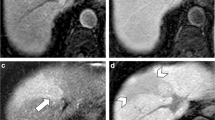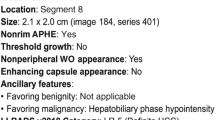Abstract
Purpose
To determine whether LI-RADS ancillary features predict longitudinal LR-3 observation category changes.
Materials and Methods
This exploratory, retrospective, single-center study with an independent reading center included patients who underwent two or more multiphase CT or MRI examinations for hepatocellular carcinoma assessment between 2011 and 2015. Three readers independently evaluated each observation using CT/MRI LI-RADS v2017, and observations categorized LR-3 using major features only were included in the analysis. Prevalence of major and ancillary features was calculated. After excluding low-frequency (< 5%) features, inter-reader agreement was assessed using intraclass correlation coefficient (ICC). Major and ancillary feature prediction of observation upgrade (to LR-4 or higher) or downgrade (to LR-1 or LR-2) on follow-up imaging was assessed using logistic regression.
Results
141 LR-3 observations in 79 patients were included. Arterial phase hyperenhancement, washout, restricted diffusion, mild-moderate T2 hyperintensity, and hepatobiliary phase hypointensity were frequent enough for further analysis (consensus prevalence 5.0–66.0%). ICCs for inter-reader agreement ranged from 0.18 for restricted diffusion to 0.48 for hepatobiliary phase hypointensity. On follow-up, 40% (57/141) of baseline LR-3 observations remained LR-3. 8% (11/141) were downgraded to LR-2, and 42% (59/141) were downgraded to LR-1. A small number were ultimately upgraded to LR-4 (2%, 3/141) or LR-5 (8%, 11/141). None of the assessed major or ancillary features was significantly associated with observation category change. Longer follow-up time was significantly associated with both observation upgrade and downgrade.
Conclusion
While numerous ancillary features are described in LI-RADS, most are rarely present and are not useful predictors of LR-3 observation category changes.




Similar content being viewed by others
References
Cerny M, Chernyak V, Olivié D, et al. LI-RADS version 2018 ancillary features at MRI. Radiographics : a review publication of the Radiological Society of North America, Inc. 2018;38(7):1973–2001. https://www.ncbi.nlm.nih.gov/pubmed/30289735. https://doi.org/10.1148/rg.2018180052.
El-Serag H. Hepatocellular carcinoma. N Engl J Med. 2011;365(12):1118–1127. http://dx.doi.org.proxy.lib.duke.edu/10.1056/NEJMra1001683. https://doi.org/10.1056/nejmra1001683.
Choi J, Lee J, Sirlin CB. CT and MR imaging diagnosis and staging of hepatocellular carcinoma. part I. development, growth, and spread: Key pathologic and imaging aspects. Radiology. 2014;272(3):635–654.
Choi J, Lee J, Sirlin CB. CT and MR imaging diagnosis and staging of hepatocellular carcinoma. part II. extracellular agents, hepatobiliary agents, and ancillary imaging features. Radiology. 2014;273(1):30–50.
American College of Radiology. Liver imaging reporting and data system version 2018. https://www.acr.org/Clinical-Resources/Reporting-and-Data-Systems/LI-RADS. Accessed January 16, 2019.
Tanabe M, Kanki A, Wolfson T, et al. Imaging outcomes of liver imaging reporting and data system version 2014 category 2, 3, and 4 observations detected at CT and MR imaging. Radiology. 2016;281(1):129–139
Chernyak V, Tang A, Flusberg M, et al. LI-RADS® ancillary features on CT and MRI. Abdom Radiol. 2018;43(1):82–100. https://search.proquest.com/docview/1992864854. https://doi.org/10.1007/s00261-017-1220-6.
Cerny M, Bergeron C, Billiard J, et al. LI-RADS for MR imaging diagnosis of hepatocellular carcinoma: Performance of major and ancillary features. Radiology. 2018;288(1):118–128
Joo I, Lee JM, Lee DH, Ahn SJ, Lee ES, Han JK. Liver imaging reporting and data system v2014 categorization of hepatocellular carcinoma on gadoxetic acid‐enhanced MRI: Comparison with multiphasic multidetector computed tomography. Journal of Magnetic Resonance Imaging. 2017;45(3):731–740. https://onlinelibrary.wiley.com/doi/abs/10.1002/jmri.25406. https://doi.org/10.1002/jmri.25406.
Choi S, Byun J, Kim S, et al. Liver imaging reporting and data system v2014 with gadoxetate Disodium–Enhanced magnetic resonance imaging: Validation of LI-RADS category 4 and 5 criteria. Investigative Radiology. 2016;51(8):483–490. https://www.ncbi.nlm.nih.gov/pubmed/26885632. https://doi.org/10.1097/rli.0000000000000258.
Mitchell D, Bashir M, Sirlin C. Management implications and outcomes of LI-RADS-2, -3, -4, and -M category observations. Abdom Radiol. 2018;43(1):143–148. https://www.ncbi.nlm.nih.gov/pubmed/28779335. https://doi.org/10.1007/s00261-017-1251-z.
Van der Pol, Christian B, Lim CS, Sirlin CB, et al. Accuracy of the liver imaging reporting and data system in computed tomography and magnetic resonance image analysis of hepatocellular carcinoma or overall Malignancy—A systematic review. Gastroenterology. 2019;156(4):976–986.
Choi J, Cho HC, Sun M, Kim HC, Sirlin CB. Indeterminate observations (liver imaging reporting and data system category 3) on MRI in the cirrhotic liver: Fate and clinical implications. AJR. American journal of roentgenology. 2013;201(5):993–1001.
J. Richard Landis, Gary G. Koch. The measurement of observer agreement for categorical data. Biometrics. 1977;33(1):159–174. https://www.jstor.org/stable/2529310. https://doi.org/10.2307/2529310.
Sano K, Ichikawa T, Motosugi U, et al. Imaging study of early hepatocellular carcinoma: Usefulness of gadoxetic acid-enhanced MR imaging. Radiology. 2011;261(3):834–844.
Chen N, Motosugi U, Morisaka H, et al. Added value of a gadoxetic acid-enhanced hepatocyte-phase image to the LI-RADS system for diagnosing hepatocellular carcinoma. Magnetic Resonance in Medical Sciences. 2016;15(1):49–59.
Suh CH, Kim KW, Pyo J, Lee J, Kim SY, Park SH. Hypervascular transformation of hypovascular hypointense nodules in the hepatobiliary phase of gadoxetic acid-enhanced MRI: A systematic review and meta-analysis. AJR. American journal of roentgenology. 2017;209(4):781–789.
Author information
Authors and Affiliations
Contributions
ES: Primary author, data collection, analysis, and data manager. AM: Data collection, analysis, and manuscript revision. TW: Study design, statistical analysis, secondary author of statistical portion, and manuscript revision. BCA, TAJ: Data collection, study reader, and manuscript revision. SI, AH, MT: Study design, data collection, and manuscript revision. AG: Study design, statistical analysis, and manuscript revision. CBS: Study design, data collection, data analysis, and manuscript revision. MRB: Study design, study reader, data analysis, manuscript revision, and corresponding author.
Corresponding author
Ethics declarations
Disclosure
Erin Shropshire, Adrija Mamidipalli, Tanya Wolfson, Brian C. Allen, Tracy A. Jaffe, Saya Igarashi, Atsushi Higaki, Masahiro Tanabe, Anthony Gamst: No grants or assistance relevant to the study, no financial disclosures. Claude B. Sirlin: Research grants: Bayer, GE, Gilead, Philips, Siemens; Personal consulting: Boehringer, Epigenomics; Representative for institutional consultation: BMS, Exact Sciences, IBM-Watson; Active lab service agreements: Enanta, Gilead, ICON, Intercept, Nusirt, Shire, Synageva, Takeda; Completed lab service agreements: Alexion, AstraZeneca, Bristol-Myers Squibb, Celgene, Galmed, Genzyme, Isis, Janssen, Pfizer, Roche, Sanofi, Virtualscopics. Mustafa R. Bashir: Research Grants: Siemens Healthcare, NGM Biopharmaceuticals, Madrigal Pharmaceuticals, Metacrine Inc., ProSciento Inc., Pinnacle Clinical Research, CymaBay Therapeutics; Consulting: MedPace.
Additional information
Publisher's Note
Springer Nature remains neutral with regard to jurisdictional claims in published maps and institutional affiliations.
IRB Statement: The institutional review board approved this Health Insurance Portability and Accountability Act (HIPAA)-compliant study.
Rights and permissions
About this article
Cite this article
Shropshire, E., Mamidipalli, A., Wolfson, T. et al. LI-RADS ancillary feature prediction of longitudinal category changes in LR-3 observations: an exploratory study. Abdom Radiol 45, 3092–3102 (2020). https://doi.org/10.1007/s00261-020-02429-2
Published:
Issue Date:
DOI: https://doi.org/10.1007/s00261-020-02429-2




